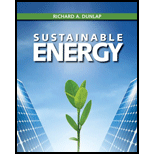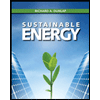
Sustainable Energy
1st Edition
ISBN: 9781133108689
Author: Richard A. Dunlap
Publisher: Cengage Learning
expand_more
expand_more
format_list_bulleted
Concept explainers
Question
Chapter 4, Problem 2P
To determine
Determine the
Determine the
Expert Solution & Answer
Want to see the full answer?
Check out a sample textbook solution
Students have asked these similar questions
A project requires 125 cubic yards of concrete sidewalk to be placed, for which 165 workhours have been budgeted. The latest weekly progress report shows that 78 cubic yards have been placed and 103 workhours have been expended to date. What is the status of the concrete placement?
Significantly under budget.
On budget.
Significantly over budget.
Status cannot be determined with information supplied.
Refer to exhibit #098. At what depth was water encountered?
What is the reaction moment at A for the frame shown?
a. 222.1 k-ft
b. 107.8 k-ft
c. 20.8 k-ft
d. 23.25 k-ft
Knowledge Booster
Learn more about
Need a deep-dive on the concept behind this application? Look no further. Learn more about this topic, civil-engineering and related others by exploring similar questions and additional content below.Similar questions
- “When a conflict exists between the project floor plans and detailed material schedule relative to size or number, which of the following usually governs in typical order of precedence?arrow_forwardWhat are the critical activitiesarrow_forwardApproximately how many pounds of water are necessary to hydrate 100 pounds of type I Portland cement? 30 50 75 94arrow_forward
- 7:05 3.1 Trabajo en clase.pptx .III LTE 8 Trabajo en clases 3.1 C9 X 20 W8 X 21 5-15. PL¹× 12 Fy = 50 klb/plg² KL = 16 pies KL 21 pies 2 plg MC 13 × 50 PL × 12 Fy = 42 klb/plg2 Fy = 36 klb/plg² 8 plg K k MC8 × 21.4 KL = 20 piesarrow_forwardThe steel frameword below is used to support the reinforced concrete slab used for an office area above the first storey. The slab is 210 mm thick. Sketch the loading that acts along members BE and FED. Use a = 2.15 m and b = 5.25 m. Refer to the 2024 OBC live load table. The unit weight for the concrete is 24.15 kN/m3.find:Loading for member BE Loading for member FED Live and Dead Loadsarrow_forwardFor the simply supported beam below, draw both the shear force (VFD) and ending moment (BDM) diagrams. Please show all equations and free body diagrams (FBD). Note: I want a cut through each of the three sections of the beam, with all related forces calculated and shown on the VFD and BMD.Reaction Forces Shear Force DiagramMaximum Shear ForceEquation for cut 1, 2, 3 respectively.Confirmation of Reaction ForcesBending Moment DiagramMaximum Bending Momentarrow_forward
- For the structural frame below, draw the shear force (VFD) and bending moment (BMD) diagrams for each of the three members of the frame. The frame is pin connected at A, C and D and fixed at joint B.Find:VFD & BMD for segment AB VFD & BMD for segment BCVFD & BMD for segment CD Reaction Forces VFD Equations BMD EquationsFree Body Diagramsarrow_forwardDetermine the horizontal and vertical reactions at A and C for the two member frame below. Use P1 = 3.2 kN, P2 = 14.5 kN/m, L1 = 3.3 m, and L2 = 2.3 m. Free Body DiagramsTriangular Load Use of Pin Reaction Forcesarrow_forwardDetermine the reaction forces at supports A and C for the compound beam. Assume C is fixed, B is a pin, and A is a roller. Use P1 = 16 kN/m, P2 = 21 kN, L1 = 3.5 m, L2 = 1.5 m, and L3 – 1.5 m. needs:Triangular Load Use of Pin Reaction Forcesfree body diagramsarrow_forward
- Determine all displacement components and internal reactions at node 2 using the stiffness method. Assume I = 300(10^6) mm4, A = 10(10^3) mm2, E = 200 GPa for each member. Use the values of L3=2.5m, L4=4.5m, w=12kN/m and P=10kN.arrow_forwardDraw the BMD of the frame on the compression side showing all salient values using the stifness method. Assume I = 300(10^6) mm4, A = 10(10^3) mm2, E = 200 GPa for each member. Use the values of L3=2.5m, L4=4.5m, w=12kN/m and P=10kN. Please show all workingarrow_forwardSchool of I- I- 30 ft C1 B1 B2 E G1 4 @ 8 ft Floor 13 Span C3 G2 4 @ 8 ft -I- 30 ft 1. Calculate the dead load, wp (kip/ft), applied to beam B2 based on tributary load analysis for the given loads and floor span direction. In addition to the weight of concrete, include an additional 25 psf dead load (total of fixed partitions, HVAC, and drop ceiling). Neglect the beam self-weight and the weight of the corrugated steel sheet metal. 2. Draw an FBD of beam B2 showing the calculated dead load, wp, and support reactions. 3. Report the maximum bending moment (kip-ft) in beam B2 due to dead load. 4. What is the minimum uniform live load, L. (psf), for this occupancy? 5. Calculate the live load, WL (kip/ft), applied to beam B2 based on tributary load analysis for the occupancy and floor span direction. 6. Draw an FBD of beam B2 showing the calculated live load, wL, and reactions 7. Report the maximum bending moment (kip-ft) in beam B2 due to live load. 8. Is live load reduction allowed for…arrow_forward
arrow_back_ios
SEE MORE QUESTIONS
arrow_forward_ios
Recommended textbooks for you

 Solid Waste EngineeringCivil EngineeringISBN:9781305635203Author:Worrell, William A.Publisher:Cengage Learning,
Solid Waste EngineeringCivil EngineeringISBN:9781305635203Author:Worrell, William A.Publisher:Cengage Learning, Sustainable EnergyCivil EngineeringISBN:9781133108689Author:Richard A. DunlapPublisher:Cengage Learning
Sustainable EnergyCivil EngineeringISBN:9781133108689Author:Richard A. DunlapPublisher:Cengage Learning Engineering Fundamentals: An Introduction to Engi...Civil EngineeringISBN:9781305084766Author:Saeed MoaveniPublisher:Cengage Learning
Engineering Fundamentals: An Introduction to Engi...Civil EngineeringISBN:9781305084766Author:Saeed MoaveniPublisher:Cengage Learning


Solid Waste Engineering
Civil Engineering
ISBN:9781305635203
Author:Worrell, William A.
Publisher:Cengage Learning,

Sustainable Energy
Civil Engineering
ISBN:9781133108689
Author:Richard A. Dunlap
Publisher:Cengage Learning

Engineering Fundamentals: An Introduction to Engi...
Civil Engineering
ISBN:9781305084766
Author:Saeed Moaveni
Publisher:Cengage Learning